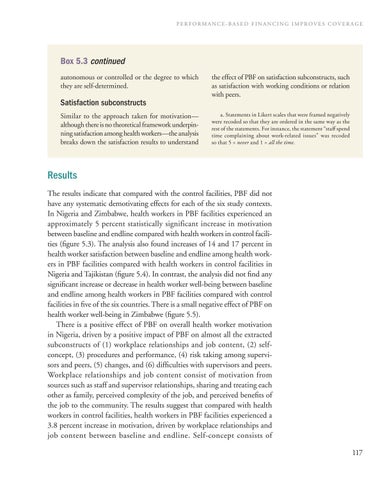P erformance - B ased F inancing I mproves C overage
Box 5.3 continued autonomous or controlled or the degree to which they are self-determined.
Satisfaction subconstructs Similar to the approach taken for motivation— although there is no theoretical framework underpinning satisfaction among health workers—the analysis breaks down the satisfaction results to understand
the effect of PBF on satisfaction subconstructs, such as satisfaction with working conditions or relation with peers. a. Statements in Likert scales that were framed negatively were recoded so that they are ordered in the same way as the rest of the statements. For instance, the statement “staff spend time complaining about work-related issues” was recoded so that 5 = never and 1 = all the time.
Results The results indicate that compared with the control facilities, PBF did not have any systematic demotivating effects for each of the six study contexts. In Nigeria and Zimbabwe, health workers in PBF facilities experienced an approximately 5 percent statistically significant increase in motivation between baseline and endline compared with health workers in control facilities (figure 5.3). The analysis also found increases of 14 and 17 percent in health worker satisfaction between baseline and endline among health workers in PBF facilities compared with health workers in control facilities in Nigeria and Tajikistan (figure 5.4). In contrast, the analysis did not find any significant increase or decrease in health worker well-being between baseline and endline among health workers in PBF facilities compared with control facilities in five of the six countries. There is a small negative effect of PBF on health worker well-being in Zimbabwe (figure 5.5). There is a positive effect of PBF on overall health worker motivation in Nigeria, driven by a positive impact of PBF on almost all the extracted subconstructs of (1) workplace relationships and job content, (2) selfconcept, (3) procedures and performance, (4) risk taking among supervisors and peers, (5) changes, and (6) difficulties with supervisors and peers. Workplace relationships and job content consist of motivation from sources such as staff and supervisor relationships, sharing and treating each other as family, perceived complexity of the job, and perceived benefits of the job to the community. The results suggest that compared with health workers in control facilities, health workers in PBF facilities experienced a 3.8 percent increase in motivation, driven by workplace relationships and job content between baseline and endline. Self-concept consists of 117

